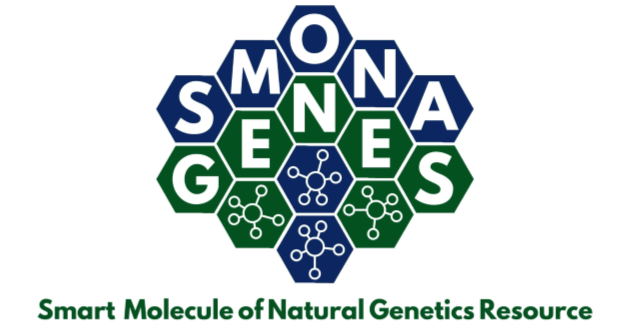A Virtual Inhibition of Anti-diabetic Activity of Bioactive Compounds in Harp (Sandoricum koetjape (Burm. f.) Merr.)
DOI:
https://doi.org/10.21776/ub.jsmartech.2023.004.02.41Abstract
The prevalence of type 2 diabetes mellitus (DMT2) has increased worldwide over the last 3 decades. This prompted the researchers to consider the medical benefits of plants, including harp (Sandoricum koetjape). In Indonesia, harp is a common medicinal herb used to cure fever, colic, vaginal discharge, diarrhea, and bloating. harp also contains substances like flavonoids, tannins, or quinones that have anti-diabetic properties. This study aims to determine the potential compound from the harp plant in inhibiting the breakdown of sugar using molecular docking to minimize the buildup of sugar in the blood. Bioactive compounds of harp were obtained from earlier studies and collected from KNApSAcK database. The physicochemical properties of the compounds were analyzed by using SwissADME and PASS Online. Using the CB-Dock server and the receptors α-amylase and α-glucosidase retrieved from RCSB PDB, along with acarbose as a control, the selected compounds were examined for their molecular interactions and binding affinities. Molecular interactions were visualized using Biovia Discovery Studio 2019. The result showed that three compounds were discovered to show potential as antidiabetic medicines out of the 54 active compounds that were screened using SwissADME. Those three compounds are sandorinic acid A, sandorinic acid B, and quercetin with the absolute value of free binding energy ranging from -7.2 to -9.6 kcal/mol. By targeting residues found in amylase and glucosidase, sandorinic acid A, sandorinic acid B, and quercetin have binding sites that are similar to acarbose. The three bioactive compounds quercetin, sandorinic acid a, and sandorinic acid b that are found in harp are expected to have the potential to be agents of type 2 diabetes mellitus.
References
S. Chatterjee, K. K and M. Davies, Type 2 diabetes, The Lancet, 2017, 389(10085), 2239-2251.
M. Tinarejo and V. Malik, An update on the epidemiology of type 2 diabetes: a global perspective, Endocrinology and Metabolism Clinics, 2021, 50(3), 337-355.
D. Simbolon, A. Siregar and R. Talib, Physiological factors and physical activity contribute to the incidence of type 2 diabetes mellitus in Indonesia, Jurnal Kesehatan Masyarakat Nasional (National Public Health Journal), 2020, 15(3), 120-127.
S. Saadah, S. Tulandi and R. Rohman, Phytochemical and gas chromatography-mass spectrometry profiling of two plant parts of S. koetjape, BIODIVERSITAS, 2020, 23(12), 6199-6207.
A. Indrakusuma, L. Wahyuni, I. Wiguna, A. Devy, I. Sasmana and A. Indrayani, Potential Effect of Secondary Metabolites in Persea americana Seeds as an alpha-amylase Inhibitor on Type 2 Diabetes Mellitus, Intisari Sains Medis, 2021, 12(3), 886-896.
G. Xiong, W. J, Y. L, F. Z, Y. C, H. M, Y. M, Z. X, W. C, L. A, C. X, H. T and C. D, ADMETlab 2.0: An Integrated Online Platform for Accurate and Comprehensive Prediction of ADMET Properties, Nucleic Acids Research, 2021, 49, 4-15.
E. N, E. Badmus, J. Marnewick, E. Iwuoha, F. Nchu and A. Hussein, Alpha-Glucosidase and Alpha-Amylase Inhibitory Activities, Molecular Docking, and Antioxidant Capacities of Salvia aurita Constituents, Antioxidants, 2020, 1-14.
M. Wijaya, Ethnomedicinal, Phytochemicals, and Pharmacological Aspects of Sentul (S. koetjape), Biology, Medicine, & Natural Product Chemistry, 2022, 1, 65-73, 11.
A. Naufal, R. Virgirinia and F. F, Molecular Interaction of Lavender (Lavendula angustifolia Mil) Essential Oil Compounds as Potential Anxiolytic Against 2δ subunit Voltage Gated Calcium Channel, Berkala Penelitian Hayati, 2023, 29(1), 1-12.
D. Maximo, M. Comin, T. Duarte, M. Foglio, J. Carvalho, M. Vieira and A. Formagio, Synthesis, Antiproliferative Activity and Molecular Properties Predictions of Galloyl Derivates, Molecules, 2015, 20(4), 1420-3049.
D. Ranjith and C. Ravikumar, SwissADME Predictions of Pharmacokinetics and Drug-Likeness Properties of Small Molecules Presents in Ipomea mauritiana Jacq, Journal of Pharmacognosy and Phytochemistry, 2019, 20(4), 1420-3049.
A. Diana, O. Michielin and V. Zoete, SwissADME: A Free Web Tool to Evaluate Pharmacokinetics Drug-Likeness and Medicinal Chemistry Friendliness of Small Molecules, Sci Rep, 2017, 7.
C. Fong, "Permeability of the blood brain barrier: molecular mechanism of transport of drugs and physiologically important compounds," Journal of Membrane Biology, 2015, 248(4), 651-669.
P. Sharma and A. Shanavas, Natural derivatives with dual binding potential against SARS-CoV-2 main protease and human ACE2 possess low oral bioavailability: a brief computational analysis, Journal of Biomolecular Structure and Dynamics, 2020, 1-12.
T. L, S. T, E. Wesely and V. Nathan, In Silico Molecular Docking on Bioactive Compounds from Indian Medicinal Plants against Type 2 Diabetic Target Proteins: A Computational Approach, Indian Journal of Pharmaceutical Sciences, 2021, 83(6), 1273-1279.
O. Ogunyemi, G. Gyebi, S. A, P. J, V. Chidozie, O. O, A. J, K. M, A. N, A. A, G. Batiha and C. Olaiya, Inhibition mechanism of alpha-amylase, a diabetes target, by a steroidal pregnane and pregnane glycosides derived from Gongronema latifolium Benth, Front Mol Biosci, 2022, 9(866719).
G. Fadimu, F. A, G. H, O. Olalere, G. C and T. T, In-Silico Analysis and Antidiabetic Effect of α-Amylase and α-Glucosidase Inhibitory Peptides from Lupin Protein Hydrolysate: Enzyme-Peptide Interaction Study Using Molecular Docking Approach, Foods, 2022, 11(21), 1-20.
M. Abukhalil, O. Hussein, B.J. M, S. Saghir, M. Germoush, H. Elgebaly, N. Mosa, H. I, M. Qarmush, E. Hassanein, E. Kamel, H.-B. R and A. Mahmoud, Farnesol attenuates oxidative stress and liver injury and modulates fatty acid synthase and acetyl-CoA carboxylase in high cholesterol-fed rats, Environ Sci Pollut Res Int, 2020, 27(24), 30118-30132.
A. Alqahtani, H. S, M. Rehman, A. Elgamal, A.M. S, V. Naumovksi, M. Alqahtani, R. El-Dib and M. AlAjmi, Alpha-Amylase and Alpha-Glucosidase Enzyme Inhibition and Antioxidant Potential of 3-Oxolupenal and Katononic Acid Isolated from Nuxia oppositifolia, Biomolecules, 2020, 10(61), 1-19.
Downloads
Published
Issue
Section
License
Copyright (c) 2023 Elvina Rashida Khairi, Rahmi Izzati, Raissa Kendra Ainiyah, Salma Wahid Marseti, Nuraini Rosyadah, Turhadi Turhadi, Fatchiyah Fatchiyah

This work is licensed under a Creative Commons Attribution 4.0 International License.
Authors who publish with this journal agree to the following terms:
- Authors retain copyright and grant the journal right of first publication with the work simultaneously licensed under a Creative Commons - Attribution 4.0 International (CC BY 4.0) that allows others to share the work with an acknowledgement of the work's authorship and initial publication in this journal.
- Authors are able to enter into separate permission for non-exclusive distribution of the journal's published version of the work (e.g., post it to an institutional repository or publish it in a book), with an acknowledgement of its initial publication in this journal.
- Authors are permitted and encouraged to post their work online (e.g., in institutional repositories or on their website) prior to and during the submission process, as it can lead to productive exchanges, as well as earlier and greater citation of published work (See The Effect of Open Access).













